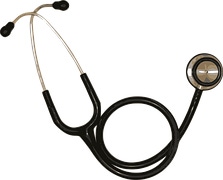Making Stethoscopes SmarterMaking Stethoscopes Smarter
Now 200 years old the doctor's stethoscope may finally be evolving as app developers make more data and diagnostic capabilities available through tablets and smart phones.
June 15, 2016

Medical technology has made significant advances in the past 50 years, but one medical device has remained a part of every doctors’ arsenal since its inception in 1816; the stethoscope. The decidedly low tech device for listening, or auscultation in medical terminology, is still the first line of examination for doctors to identify ailments from lung disease to heart disease and intestinal issues. While the stethoscopes have evolved and become better, the tool itself and its usage have remained a constant in medical training.
For years, medical students in training would visit patients with various ailments to hear their ailments on a stethoscope. This training, it was hoped, would prove valuable in their own practices. But at best, these sessions could only provide a glimpse of all ailments and their manifestations. Even with the best exposure, students needed to remember those sounds, possibly for years, until they encountered that particular ailment again. The stethoscope is an essential tool, but it is subjective and experience driven. Recent research is now indicating that medical mistakes are the third leading cause of death in the US, making subjectivity and training a critical issue in patient survival.
Technology is now bridging the gap to supplement training and help eliminate subjectivity through apps for stethoscopes. The apps provide a simple and easy classification for types of ailments in children and adults, with accompanying visual and audio of how they would be manifested in a patient. While the app still requires a human interpretation it can provide a physician with an indicator of a diagnosis they may have missed.
Medical manufacturer 3M introduced their latest electronic stethoscope with an accompanying app that assists doctors in hearing what different ailments may sound like on their stethoscope. The database is regularly updated with patient cases and backgrounds to provide seasoned physicians and new physicians with a vast database of stethoscope data to access from their smartphone or tablet.
This type of analysis and compilation of stethoscope data can save lives. The compilation of data for adults and children provides physicians instant access to what might have taken them years to experience and assimilate into their diagnosis. This is just one example of how data and technology are being used to enhance the most traditional of diagnostic tools. There are entire websites dedicated to medical apps now available to physicians, including imedicalapps.com, that provide reviews and a resource list of the latest medical apps. These apps help with diagnosis, medication dosing, and a myriad of other medical practices that in the past were committed to memory or learned through training.
Providing databases of collected medical can expand and expedite physician training. What once was a hands-on only experience can now be studied and implemented from a smart phone in any type of medical location. This is especially important in rural and underprivileged areas where physicians have limited access to resources, infrastructure, and peer groups.
While some may find this app very valuable others may find it disconcerting that their physician would need to refer to such an app for assistance. Privacy is also an issue if the physician loads patient data into the app databases without their knowledge. Currently, the app does not diagnose the stethoscope sounds for a physician against its database but it may become something we see in the future, as these types of apps and databases are expanded.
Read more about:
2016You May Also Like




